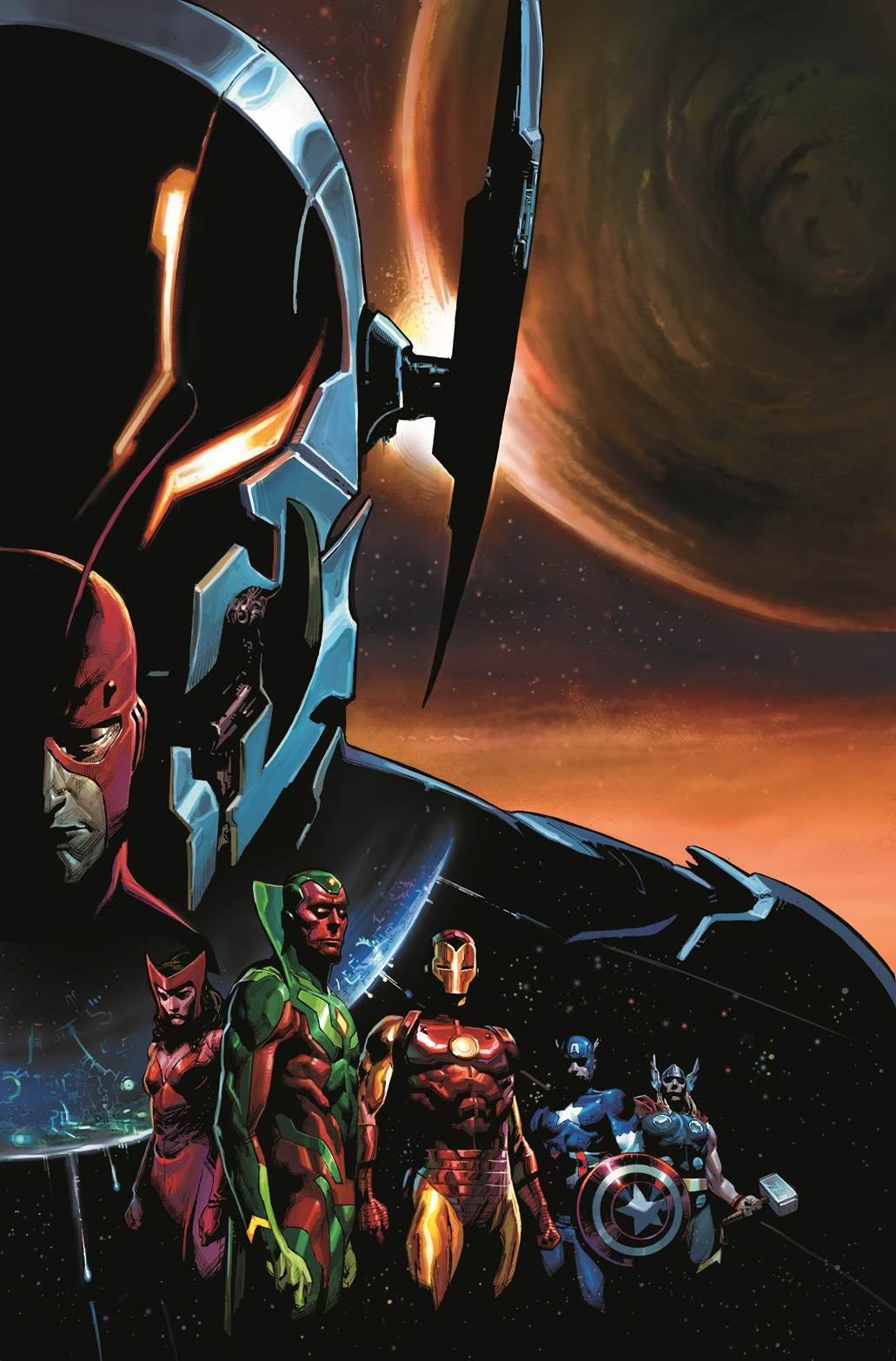Roughly the same size as the classic Marvel original graphic novels from the 1980s, "Avengers: Rage of Ultron" is a new, evergreen option from Marvel that gives readers a complete adventure written by Rick Remender and drawn by Jerome Opeña and Pepe Larraz. While continuity buffs might lose their minds trying to squeeze this in between all the various appearances of Ultron, this is an entertaining and concise offering that touches on many of the aspects of Remender's work at Marvel while giving readers plenty of starting points for further investigation.
The opening scene showcases an Avengers line-up that includes Captain America, Thor, Iron Man, Wasp, Yellowjacket, Hawkeye, Vision, Scarlet Witch and Beast. This team is defending Manhattan from Ultron's attack, which establishes a solid foundation for readers to latch onto regardless of previous exposure to the Avengers, Ultron or even Marvel comics.
Remender's dialogue feels like it was peeled right out of the Avengers comics from the late 1970s, with Beast and Hawkeye taking turns inserting humor into an otherwise tense situation. When Cap delivers a one-liner, the resultant conversation with Beast reveals as much about their relationship and trust as a five-hundred-word essay, a scene Remender captures in just one panel. As a reader who discovered the Avengers in those fondly-remembered "glory days" of the '70s and '80s, I couldn't help but smile at the opening pages of "Avengers: Rage of Ultron," which eased away any crossover concerns or event fatigue. This is a straightforward adventure that pays homage to the history of the Avengers.
It isn't all adventuring and punching indestructible robots, however, as Remender spends a significant amount of time investigating the relationship between Ultron and his creator, Hank Pym. Ultron, in turn, created Vision, so Remender has plenty of Oedipal issues to lay on readers throughout this comic. The writer doesn't let that dominate the flow of this story, however, as he gives readers a solid battle with a slippery projected outcome, a few surprises along the way and a startling, emotional conclusion.
Starfox also makes his triumphant return to Avengers lore here. Finding a different team than he knew when he served as an Avenger, the Eternal known as Eros alerts the group to the new, reinvigorated threat Ultron poses, which serves as a gorgeous constructed bridge from the late 1970s Avengers line-up to a slightly modified version of Remender's current "Uncanny Avengers" lineup. Scarlet Witch is still around, but Captain America is now Sam Wilson, Thor is the current female version and Vision is considerably different. The line-up also includes Spider-Man, Sabretooth and Quicksilver. Giant-Man (Pym) and Wasp round out the roster, bringing the necessary dramatic lineage to make this story succeed. Without naming names, one of those characters has been off-grid for a little while, adding further consternation for continuity disciples. Regardless of that wrinkle, all of the parties present in "Avengers: Rage of Ultron" -- including the Descendants from Remender's "Secret Avengers" run -- are integral to adding to the gravitas in this original graphic novel.
Jerome Opeña and Pepe Larraz's artwork is nothing short of magnificent. Opeña's style is slightly darker, his figures leaner and their expressions less rangy, but the two artists blend together nicely to give readers some gorgeous, study-worthy drawings. Beast leaping into the fight in Manhattan is exactly the right image to follow up Ultron's proud declarations; Opeña delivers stunning differences between the robotic attacker and the bouncing blue mutant.
Throughout the book, Kirby crackle pours out of Ultron and his omnipresence in all of the battle sequences. Larraz carries that notion through his pages, which vary just enough from Opeña's to be almost noticeable. Larraz and Opeña are a surprisingly good combination to draw a book together. While their styles are only vaguely similar, their page set-ups, pacing and storytelling flow nicely from one to the other. As Ultron makes his appeal to Hank Pym, the robotic fiend assumes aspects of Pym's appearance, translates them into his own and changes throughout the course of this book, which also underscores the story and gives readers some visual breadcrumbs to follow.
Letterer Clayton Cowles brings consistency to the tale while making subtle variations between the past and present day word balloons from Ultron and Vision. Each has changed a bit from their first appearance in this issue and their evolution is quite obvious by the end of the book.
Another wonderful surprise is the cohesiveness "Avengers: Rage of Ultron" carries despite having three colorists. Rachelle Rosenberg and Dono Sanchez Almara seem to have a similar, classic comic style with bold, vivid coloring throughout. Dean White's style is more sketchy, almost like conte crayons or pastels. White handles the opening sequence and a vast amount of the book's remainder, and his style is innovative enough to feel at home in the original graphic novel format. Marvel once used the OGNs to experiment with characters and processes, and White's coloring carries that on in as fine a tribute as Remender's script.
Remender, Opeña, Larraz, Morales, White, Rosenberg, Almara and Cowles do a grand job making this both new reader friendly and openly appealing to longtime fans of the Avengers. Clocking in around one hundred pages, "Avengers: Rage of Ultron" is a fine example of what original graphic novels can and should be in an era where books are still more prevalent and readily-accessible than comics, especially to casual fans. This is a smart package that delivers a complete, well-paced and entertaining story with plenty of continuing adventure opportunities. Until that point, however, this is a story that can be read and re-read, shared with others and read again. Each time, I'm certain Avengers fans, regardless of their history with the team, will find more to appreciate.

